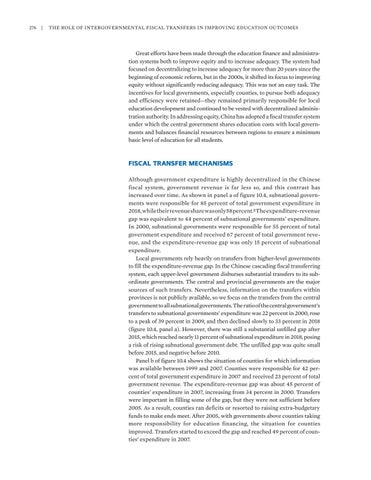276 | The Role of Intergovernmental Fiscal Transfers in Improving Education Outcomes
Great efforts have been made through the education finance and administration systems both to improve equity and to increase adequacy. The system had focused on decentralizing to increase adequacy for more than 20 years since the beginning of economic reform, but in the 2000s, it shifted its focus to improving equity without significantly reducing adequacy. This was not an easy task. The incentives for local governments, especially counties, to pursue both adequacy and efficiency were retained—they remained primarily responsible for local education development and continued to be vested with decentralized administration authority. In addressing equity, China has adopted a fiscal transfer system under which the central government shares education costs with local governments and balances financial resources between regions to ensure a minimum basic level of education for all students.
FISCAL TRANSFER MECHANISMS Although government expenditure is highly decentralized in the Chinese fiscal system, government revenue is far less so, and this contrast has increased over time. As shown in panel a of figure 10.4, subnational governments were responsible for 85 percent of total government expenditure in 2018, while their revenue share was only 58 percent.6 The expenditure-revenue gap was equivalent to 44 percent of subnational governments’ expenditure. In 2000, subnational governments were responsible for 55 percent of total government expenditure and received 67 percent of total government revenue, and the expenditure-revenue gap was only 15 percent of subnational expenditure. Local governments rely heavily on transfers from higher-level governments to fill the expenditure-revenue gap. In the Chinese cascading fiscal transferring system, each upper-level government disburses substantial transfers to its subordinate governments. The central and provincial governments are the major sources of such transfers. Nevertheless, information on the transfers within provinces is not publicly available, so we focus on the transfers from the central government to all subnational governments. The ratio of the central government’s transfers to subnational governments’ expenditure was 22 percent in 2000, rose to a peak of 39 percent in 2009, and then declined slowly to 33 percent in 2018 (figure 10.4, panel a). However, there was still a substantial unfilled gap after 2015, which reached nearly 11 percent of subnational expenditure in 2018, posing a risk of rising subnational government debt. The unfilled gap was quite small before 2015, and negative before 2010. Panel b of figure 10.4 shows the situation of counties for which information was available between 1999 and 2007. Counties were responsible for 42 percent of total government expenditure in 2007 and received 23 percent of total government revenue. The expenditure-revenue gap was about 45 percent of counties’ expenditure in 2007, increasing from 34 percent in 2000. Transfers were important in filling some of the gap, but they were not sufficient before 2005. As a result, counties ran deficits or resorted to raising extra-budgetary funds to make ends meet. After 2005, with governments above counties taking more responsibility for education financing, the situation for counties improved. Transfers started to exceed the gap and reached 49 percent of counties’ expenditure in 2007.






